How do you follow up a runaway success like 2001's Grand Theft Auto III? Rockstar North responded a year later with GTA: Vice City, a game that took the gameplay of its predecessor and expanded it considerably. At the same time, Vice City gave the series an extensive and amazing stylistic makeover, drenching the experience in the sights, sounds, and attitude of Miami, Florida from the mid '80s. So where do you go from there? You take it statewide. Grand Theft Auto: San Andreas expands the series' concept to encompass three entire cities, as well as the countryside between them. The gameplay similarly expands, packing in some explosive set pieces and amazing action-movie-like thrills while maintaining that same remarkably fun, freefom GTA feel. In short, Rockstar has done it again. San Andreas definitely lives up to the Grand Theft Auto name. In fact, it's arguably the best game in the series.
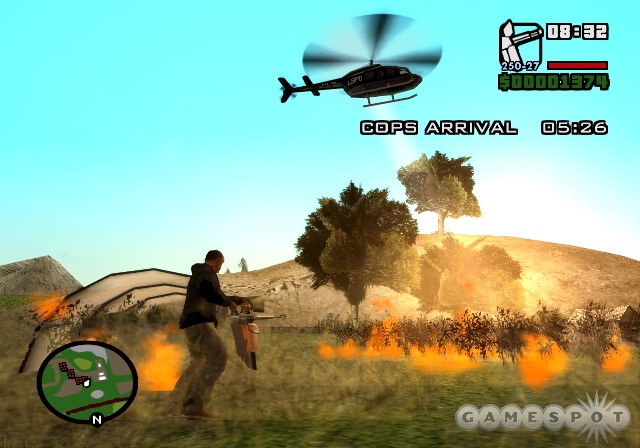
This latest installment takes place in 1992 in the West Coast-themed state of San Andreas. San Andreas is an island containing three cities. You'll begin the game in the city of Los Santos, which is based roughly on Los Angeles and consists of a mixture of ritzy downtown areas and the gangland ghettos of South Central. San Fierro is based on San Francisco, reproducing the real city's hilly terrain and ever-present fog. The game's third city is Las Venturas, which is a great take on early-'90s Las Vegas, complete with a strip full of casinos and the surrounding desert. While one-to-one measurements against previous games in the series are difficult in practice, San Andreas definitely feels like a much, much larger place than Vice City ever did, but at the same time, the growth is handled intelligently. There are plenty of things to do both in and out of the cities, which makes all this real estate matter.
While Grand Theft Auto III was inspired by movies like The Godfather and Vice City took several pages from the Scarface playbook, San Andreas draws its inspiration from the ghetto and gangsta struggle films of the early '90s. Movies like Menace II Society and Boyz N the Hood are the clear influences here. In San Andreas, you play the role of Carl "CJ" Johnson. The game opens with Carl returning to Los Santos after spending the last five years in GTA III's Liberty City. But his homecoming isn't a happy one--he's returning home because his mother has been killed. Carl isn't on the ground for more than an hour before he's picked up by a pair of crooked cops and thrown right back into the middle of the street life he left Los Santos to avoid.
Your first order of business in Los Santos is to put your set back on the map. Your gang, the Grove Street Families, has fallen into disarray over the last five years, and their influence is minimal at best. So you, along with the three other leaders of the gang--the long-winded Big Smoke, the dust-smoking Ryder, and your stubborn brother, Sweet--set out to take back the streets from your rivals, the Ballas, who have turned to dealing crack to earn money and gain influence in the hood. You set out on a series of missions to take back your territory, starting small with things like spray-painting over other gangs' tags (which is one of the many new types of actions that replace previous GTA games' more-generic hidden package collecting here), but quickly moving up to drive-bys and other acts of extreme gangsterism. But there's a whole lot more to San Andreas than just set tripping.
Just when you think you're getting used to gang warfare, everything goes sour. We're certainly not interested in spoiling the game's many interesting plot twists, so we'll leave out the details, but it should suffice to say that you'll eventually need to get the heck out of Los Santos. You wind up in the country outside the city, where you'll encounter many more great characters and officially embark on your quest to put right what's gone wrong. Once you get out of Los Santos, you won't really have to worry about gang warfare for a while, and the game settles down into a more GTA-like feel.
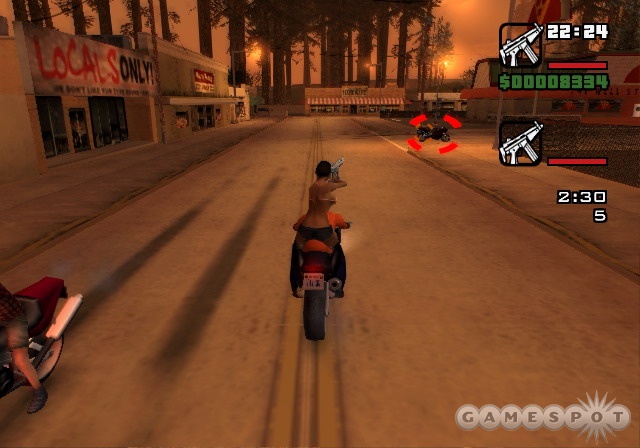
Like the previous games in the series, San Andreas features a fairly linear story that takes you through the game's areas. You'll start off restricted to Los Santos--something the story justifies by claiming that an earthquake has taken out the bridges and roads that link Los Santos to the surrounding area--but it doesn't take long to unlock the other two areas. The game also throws in some pretty great surprises in the form of characters from previous entries in the series. These characters tie the GTA games together really nicely, so while San Andreas feels pretty different from the other games in the series, it still feels like you're playing in the same universe.
As in the previous games, most of your progress is accomplished by completing missions for a variety of individuals. These missions are oftentimes similar to missions you've seen in previous games in the series. You'll drive people around, take out specific individuals (an early mission gives you the straightforward objective of beating up a crack dealer, for example), do drive-bys on your enemies, and so on. But as you proceed through the game, the missions get crazier and crazier. Along the way you'll pull off a daring casino heist, steal some wicked military hardware, "take care" of plenty of Mafia bozos, and much, much more. The missions in the game are a lot more exciting, on average, than they have been in some previous GTA games. Additionally, the game is a lot better at spelling out what, exactly, needs to be done. It does this with onscreen text that color-codes each specific piece of a mission differently. Yet while the basics of the gameplay--taking on and completing missions--are similar to past GTA games, there are plenty of details to uncover, and plenty of new things to try.
The first addition to the game is the ability to ride a bicycle, which you encounter almost immediately upon starting the game. You'll ride it like any other vehicle, but you'll find that tapping the X button makes CJ go faster. This is true on foot, also, as holding X will make you sprint, but tapping it makes him super sprint. The melee combat is a bit deeper now, as you can block and execute combo moves with the square and triangle buttons, respectively. The targeting system has received a slight overhaul that makes it look more like the targeting in Manhunt, but it's functionally very similar to the system in Vice City. CJ is also a little more athletic than previous GTA protagonists. For one thing, he can swim, both on the surface and underwater, which causes a breath meter to appear near your newly redesigned health meter. And if CJ's in shape, he can jump up and climb over high walls.

Yes, that's right. CJ needs to stay in shape if he's to perform at his best, which is a new feature for the GTA series. The game keeps track of a lot of different statistics that increase and decrease as you play the game. Your physical fitness is the most overt statistic, as you're able to work out in gyms to work on your muscle and stamina ratings, and you'll have to occasionally eat to prevent your muscle stat from occasionally draining a bit. Eating, however, can increase your fat statistic. CJ's body shape will change, depending on what you do and for how long. While this might sound like a whole lot of busywork, it's actually a very small part of the game, and the best way to handle it is to spend a few minutes working out in the early parts of the game to build up your muscle (giving you a bonus to your melee attacks) and your stamina (which dictates how long you can sprint before getting tired), and then eating occasionally to maintain the ratings without gaining too much fat. You really don't have to spend too much time on it, and earning the ability to sprint for long periods of time makes getting around (and getting away) much easier.
The game also tracks a lot of other statistics. Respect is a big one, as it's what you'll be earning the most of as you complete missions. Not all missions earn you money, but almost all of them are good for a slight respect bonus. A higher respect rating lets you recruit more and more gang members to follow you around and shoot at rival gangs, which is another new addition and a nice perk, but not something that comes in handy very often. You're also rated in a lot of different vehicle categories, like driving, riding motorcycles, bicycling, and piloting aircraft. As you use a vehicle, your skill with it slowly increases, which seems to tighten up the controls a bit. In the case of motorcycles, it also makes it less likely that you'll fly off the bike in a wreck. Your bicycling skills translate into higher bunny hops. Similarly, you're given stats for every type of firearm in the game. You'll start with poor skills with all weapons, but don't let the tag of "poor" fool you--CJ's skills feel roughly the same as Tommy Vercetti's when you first squeeze the trigger. After getting in some time with a weapon, you'll upgrade it to "gangster" level, which extends your lock-on range with the weapon, speeds up reloading, and in some cases lets you walk around while locked on. Upgrading your skill with a weapon to the highest level, "hitman," takes a relatively long time, but it extends the lock-on range and speeds up reloading even further, and it also opens up the ability to dual-wield some one-handed weapons. Unloading two full clips of submachine-gun ammo is extremely satisfying here.
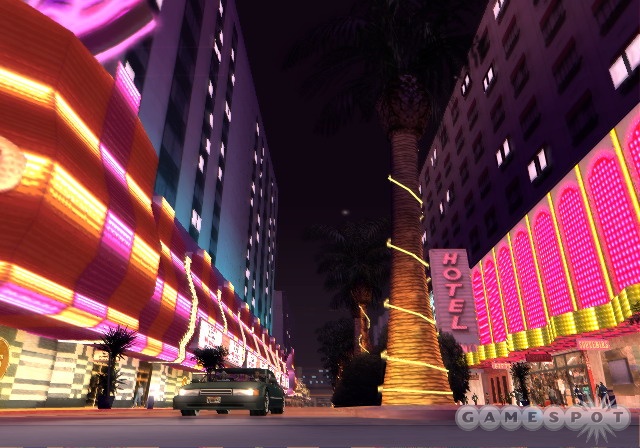
Probably the best part about the game's stat system is that it's all extremely subtle. It would be easy for something like exercise and eating to monopolize the game, but in practice you really don't have to think about it. All you really see is a quick pop-up in the upper left-hand corner of the screen whenever a stat changes, and if it's changed enough to make a big difference, the game offers a text description of what has changed and what that means for you. You will have to think about your stats a bit when you come across the first flight mission, as the story won't proceed until you've gone through flight training. The training program is frustrating, but once you pass it, the flight controls seem to tighten up a bit, and you'll have had enough practice to make it through most of the flight missions without too much trouble. The other time you'll think about stats is when you first take on a mission that requires swimming. If you haven't leveled your lung capacity up to a certain point, you simply won't be able to continue. Up until that point in the story, though, you haven't had to go underwater at all, so at the beginning of the mission you'll have to spend some time going underwater and resurfacing until you've developed the lungs required to swim out to a boat and silently kill everyone on board.
But enough about statistics. The important thing about GTA: San Andreas is that it's insanely fun to play, regardless of how you decide to play it. The missions are less frustrating this time around--there are still plenty of challenging objectives for you to meet, but the game does a better job of pacing the missions and keeping you informed about what you're supposed to do next. As a result, players who might not have been able to complete Vice City will have a better chance of finishing San Andreas' story, but at the same time the game never really feels like it's too easy. Experienced players should be able to make their way through the game's epic tale in 35 to 40 hours, though if you've been playing Vice City every day in anticipation of this game's release, that number could conceivably fall as low as 25 to 30--which is a pretty lengthy adventure, any way you slice it. On top of that, players who stick to the critical story path and ignore all the side stuff will finish the game with a completion percentage somewhere in the 50s, so obviously there's a lot more to San Andreas than just getting out of the hood and building a criminal empire. Even players who devote all their time in GTA to causing mass destruction will still have a great time here, though you may want to play through the story long enough to unlock the game's other areas. And this time, you'll be able to start trouble with a friend.
One of the many interesting wrinkles in GTA's gameplay is that the game now has a two-player cooperative mode. Now, before you get too excited about this, you should know that you can't actually play the entire game with a friend. Instead, you'll run into little two-player icons in certain spots in the gameworld. Walking over one with a second controller plugged in lets you start up a series of special objectives that work sort of like the rampage icons in previous GTA games. You and a friend will be able to wreak havoc in a car or on foot, though the game requires that both players remain on the same screen. While the concept of a multiplayer mode in GTA is pretty mind-blowing, the implementation here makes it more of a fun little addition that, along with all the other crazy things you'll come across as you play, contributes to the feel that the game has a million different things for you to uncover. OK, while there aren't quite a million side missions in the game, it seems to come pretty close, offering everything from a basketball minigame, to pool games played for money, to arcade machines that pay homage to classic games like Gyruss and Gradius.
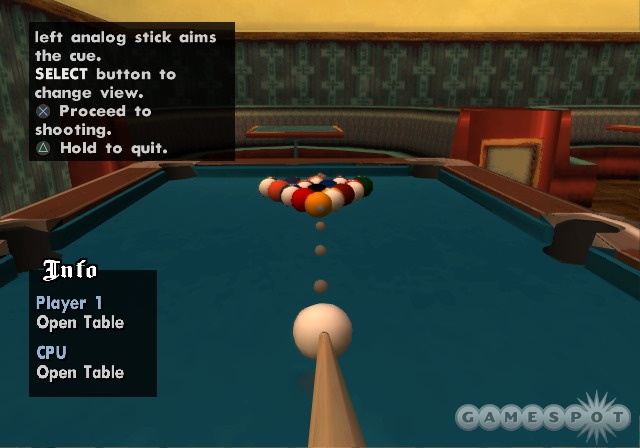
Some of the missions that have been with the series for years reappear here. When you enter a police vehicle, you can hit the R3 button and take on some vigilante missions. The same thing goes for fire trucks and ambulances. If you get into a moving van at night, you can embark on a home-invasion mission, which is a stealthy task that requires you to enter a home and make off with some goods without making noise. Walking when crouched is the order of the day here. You'll also find an assortment of races, ranging from the good old dirtring to well-hidden mountain-bike challenges. Another interesting facet of the game is that you'll get to hook up with a variety of women. The story requires you to dabble in the game's dating system, which sets you up with specific women at different points in the game, but there are plenty of other girls you can take out, if you have the look and style they're searching for. Dates are usually pretty simple: You pick up the girl, and usually she wants to eat. It's up to you to drive her someplace. If she's thinking lobster, but you're thinking Burger Shot, the date's not going to go particularly well, but there are a variety of nice places to go. You don't usually take any control during the date other than driving her to the location and back to her house, but if she wants to go dancing, the game launches into a simple Dance Dance Revolution-like timing minigame. In an awesome touch, this same type of minigame appears when you enter a lowrider-hopping contest, which is a good way to earn a little extra cash.
The Grand Theft Auto series has always been rather stylish, visually speaking. Vice City did an amazing job of capturing both the look of Miami and the feel of the mid '80s. San Andreas has to live up to that standard while creating four unique landscapes--one for each city, and one for the countryside between cities. Fortunately, the game does this very, very well. The parts of Los Santos that you call home have a very realistic ghetto look that fits perfectly. The other cities in the game also look a lot like the towns they're modeled after, but the most dramatic difference occurs when you leave town. The countryside is unlike anything you've seen in previous GTA games. The winding country roads, the small towns that pepper the landscape, plenty of off-road action, and lots of nice-looking foliage make these areas look pretty amazing. Outside of Las Venturas, the area is much more desertlike, which also looks really great. And there's no loading time separating up all the landmass.
The architecture looks outstanding, and the game has some new effects to match. The old trails effect from Vice City and GTAIII is history. Now, you'll see everything pretty clearly, but when you're in warm areas, the game has a nice heat-shimmer effect. When you're moving at or near top speed in a car, the screen blurs a bit, which does a fantastic job at conveying an extreme sense of speed. Also, the game takes on a grainy, filtered look when it rains, which also looks really good. The character models throughout San Andreas look very good as well, though some aspects, like the characters' blocky hands, look a little weird at times.
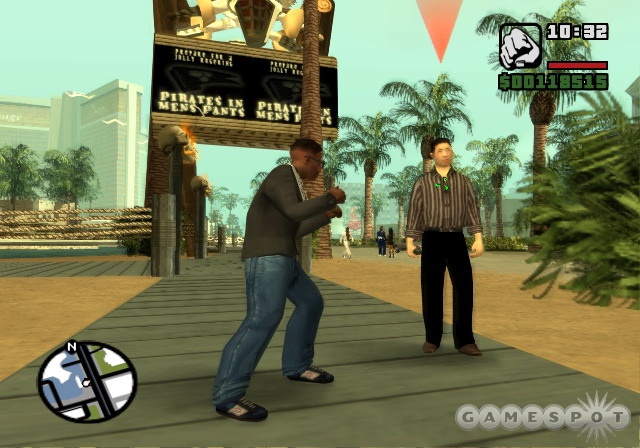
It's not all fun and sun when it comes to San Andreas' graphics, though. As in previous GTA games, the frame rate in San Andreas is pretty unstable. It always runs at a playable rate, but depending on what you're doing, how fast you're doing it, and how many other objects are onscreen, the frame rate can vary wildly. Additionally, there are some occasional level-of-detail issues, where you'll be able to get pretty close to an object before its "looks good up close" texture can load in. This sort of problem will probably vary, depending on the condition of your hardware. If your PS2 is new and fresh, you probably won't see it too often. But if your system has seen better days, it might have trouble keeping up with you when it comes to streaming in the new textures and landscapes. The draw-in distance seems a lot further out than Vice City's, but you'll still see some structures pop into view, especially when flying overhead at high speed. But even when you take these issues into consideration, San Andreas delivers a really impressive-looking graphical package on the aging PlayStation 2 hardware.
The sounds of San Andreas are, as you'd expect, many and varied. The game does a really strong job with things like engine noises. Vehicles like jets (yes!), fast cars, and motorcycles all deliver deep, throaty tones that make them sound as fast and powerful as they really are. Gunfire sounds about like you'd expect, and the game's Pro Logic II support does a fine job of positioning the audio properly. San Andreas doesn't have DTS support, as Vice City did, but you probably won't notice any real difference. On the other hand, you'll surely notice how the quality of the voice work has improved since that game.
In a story-driven game like San Andreas, the voice cast has a profound effect on the story's impact. Rockstar has assembled a fantastic cast for the game that, down to a person, does a great job with the dialogue. While there are definitely some recognizable names on the cast list, the game doesn't go overboard in this respect, casting a relatively unknown rapper by the name of Young Maylay in the role of CJ--and he delivers an excellent performance. MC Eiht, an inspired inclusion to say the least, does a great job with the role of Ryder. Samuel L. Jackson does some fine work in the role of the dirty cop, Officer Tenpenny. Comedian David Cross is pretty funny in the role of the nerdy hobby store owner, Zero. Peter Fonda is very strong as a hippie/conspiracy theorist known only as "The Truth." Charlie Murphy, best known for his appearances on Chappelle's Show, does well in the role of a pimp named Jizzy B. Even Ice-T turns up as a rapper named Madd Dogg. But the best role in the game goes to James Woods, who is absolutely incredible in his role as Mike Toreno. To mention too much about his role in the story would give away a plot point or two, but your time spent with Toreno--both in the cutscenes and in the actual missions that surround this segment of the story--is some of the best and most uniquely rewarding that San Andreas (and, therefore, Grand Theft Auto) has to offer.

The in-car radio was one of the most effective tools that GTA: Vice City used to make the game feel like it took place in the '80s--having hours and hours of great music to choose from was among the game's most noteworthy features. San Andreas contains some pretty strong radio stations, but the overall selection is a little too scattered. The rap station, Radio Los Santos, is the most fitting, at least for the gang-related segments of the game. With songs from Dr. Dre, Compton's Most Wanted, and Tupac Shakur, this station does a good job of sounding like Los Angeles radio, circa 1992. The other stations, however, don't set the tone nearly as well. There's a classic-rock station, a classic-rap station (Did classic-rap radio even exist in 1992? Heck, does classic-rap radio exist today?), a country station, an alternative station, a funk station, a talk-radio station, and so on. While the rap station and the alternative station do passable jobs of delivering the music of the era, you'll probably be able to quickly rattle off 10 or 15 songs you would've liked to have heard instead. With the inclusion of things like a country station and a classic-rock station, it almost seems like the game's developers felt the need to offset the game's thuggish subject matter, and ended up with a soundtrack that isn't quite as cohesive as Vice City's.
One neat thing is that the radio sounds different depending on which vehicle you're in--so, for example, the radio will sound appropriately tinny on a dirt bike. You can even go purchase a bass boost for your car at the mod shop, but considering the disposable nature of vehicles in a Grand Theft Auto game, we recommend you save your money. Also, it's worth noting that the radio stations are the same, regardless of where in the gameworld you are. It would have been neat to have seen some of your station selections change as you drive from one city to the next.

The DJs on the radio do a good job, and the radio commercials feature the same style of tongue-in-cheek humor that you've come to expect from the series. Some celebrities make appearances as DJs. Public Enemy's Chuck D plays the DJ of the classic-rap station, George Clinton mans the funk station, and Axl Rose turns in a low-key but appropriate performance as the DJ of the classic-rock station. The talk radio in the game is, for the most part, pretty good. The most impressive thing about the talk station is that the news breaks update as you play the game. So you'll hear updates about, for example, a "mysterious" ship full of dead bodies found floating out at sea shortly after that swimming mission of yours. Lazlow returns with some great "celebrity" interviews, but you'll also hear a sports show, a matchmaking program, and a gardening show whose host is played by the never subtle Andy Dick.
Usually, when a game tries to do a million different things, it's an overambitious hodge-podge that can't manage to get its different parts down cold. Grand Theft Auto: San Andreas has you doing many, many more things than any previous GTA game, and while some of them do work a little better than others, the strength of all these different gameplay elements--too many to count--makes for a powerful package that does not disappoint, despite the extremely high standards that Grand Theft Auto established and that San Andreas needed to live up to. With its strong story, well-written dialogue, terrific voice cast, impressive graphics, great in-game sound, and extremely entertaining and varied gameplay, Grand Theft Auto: San Andreas is a stupendous thrill ride that shouldn't be missed.